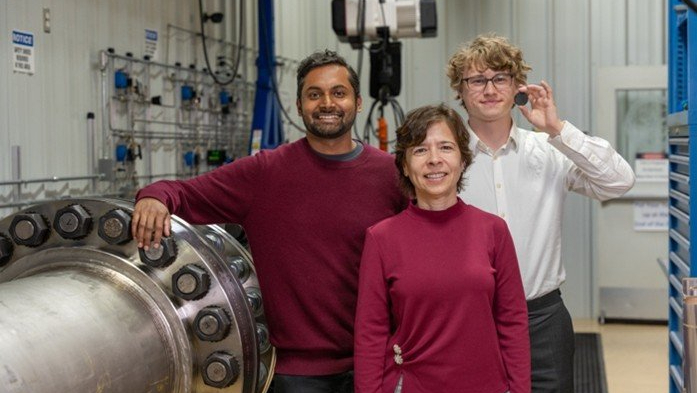2022 was one of the warmest years in recorded history despite cooling La Niña conditions governing the tropical Pacific Ocean.
What is worse, concentrations of warming greenhouse gases in Earth’s atmosphere reached new highs last year, while polar regions continued warming at a breakneck pace, according to new data released by the world’s leading climate-monitoring agencies.
Earlier this week, NASA, the U.S. National Oceanic and Atmospheric Administration (NOAA) and the European environment monitoring program Copernicus all released their respective assessments of climate change‘s progress during 2022, revealing an unabated rise in average temperatures worldwide.
Globally, 2022 was the fifth warmest year on record, according to NASA (opens in new tab) and Copernicus (opens in new tab). (NOAA (opens in new tab) places the recently concluded year in the sixth spot with a marginal difference.) But some parts of the world — including western Europe, the Middle East, Central Asia, China and north-western Africa — notched their hottest 12 months in history.
Related: 10 devastating signs of climate change satellites can see from space
The last decade has had 9 of the 10 hottest years in history
All of the hottest years on record have occurred since 2010, with the past nine years the warmest “since modern record-keeping began in 1880,” NASA said in the statement.
“When you look at nine of the past 10 years, they’re the warmest years in the modern record since 1880, and that’s pretty alarming,” NASA Administrator Bill Nelson said in a joint NASA/NOAA news conference on Thursday (Jan. 12), when the new data was released. “If we don’t take it seriously and have some real action to mitigate [the trend], there are going to be deadly effects across the globe.”
In 2022, the planet was on average about 2 degrees Fahrenheit (1.1 degrees Celsius) warmer than in the late 19th century, just 0.7 degrees F (0.4 degrees C) short of the threshold set by the global climate science community as a tipping point to avoid in order to prevent severe and unpredictable environmental consequences. According to Europe’s Copernicus program, 2022 was also 0.54 degrees F (0.3 degrees C) warmer than the already warm average for the 1991 to 2020 period.
“It’s certainly warmer now than probably at least during the past 2,000 years, probably much longer,” Russel Vose, a NOAA physical scientist, said in the news conference. “And the rate of [temperature] increase over the past 50 years has been faster than any time in the past two millennia.”

Record despite cooling La Niña
2022 scored in the top 10 hottest years on record, on par with 2015, despite the fact that the so-called La Niña effect governed the tropical Pacific Ocean. During La Niña years, surface water temperatures in eastern parts of the central Pacific drop, which in turn results in wetter and cooler weather conditions across large portions of the world.
On the contrary, 2015, which was as warm as 2022, according to the newly released data, was an El Niño year, featuring warmer tropical Pacific surface water temperatures and overall drier and warmer weather conditions across the globe.
“NASA scientists estimate that La Niña’s cooling influence may have lowered global temperatures slightly (about 0.11 degrees F, or 0.06 degrees C) from what the average would have been under more typical ocean conditions,” NASA said in the statement.
Vulnerable poles warming at breakneck pace
The globe is not warming evenly. In fact, some of the most vulnerable regions have already smashed through the 2.7 degree-F (1.5 degrees-C) threshold. The fragile polar regions are warming exceptionally fast, with some areas in Antarctica and Siberia having logged temperatures 3.6 degrees F (2 degrees C) above the 1991-2020 averages in 2022, according to Copernicus. The warmth exacerbated annual sea ice loss, with the Antarctic region recording its second all-time lowest sea ice extent last year. Only 1987 saw more widespread sea ice loss during the peak of the Antarctic summer.
Earlier NASA-backed research (opens in new tab) revealed that the Arctic, the floating ice cap covering Earth’s north pole and the surrounding regions of northern Europe and Asia, may be warming at a mind-boggling rate, four times faster than the global average. And this trend is not expected to subside, hinting at a future of accelerating ice sheet thawing and sea level rise.

Greenhouse gas concentrations at new highs
Scientists are quite certain that further record and near-record years lie ahead. Apart from making the top 10 for highest temperatures, 2022 also saw an increase in concentrations of carbon dioxide and methane in the atmosphere, the two chief contributors to the ever-increasing warming. According to Copernicus, there hasn’t been this much carbon dioxide in the air in the last 2 million years, while available scientific evidence shows that concentrations of methane are at their highest in over 800,000 years.
“Preliminary analysis of satellite data averaged over the whole atmospheric column shows that carbon dioxide concentrations rose by approximately 2.1 ppm [parts per million], while methane rose by around 12 ppb [parts per billion],” Copernicus said in a statement. “This resulted in an annual average for 2022 of approximately 417 ppm for carbon dioxide and 1,894 ppb for methane.”
The concentrations of carbon dioxide, which is mostly released by the burning of fossil fuels, have increased by 50% since the pre-industrial era, Vose said.

According to NOAA, global ocean heat content was at an all time high in 2022, meaning that the overall amount of energy accumulated in the upper 6,500 feet (2,000 meters) of the world’s globally connected ocean has never been higher. The increasing amount of heat is likely to exacerbate many negative effects of climate change, including sea level rise, further thawing of polar ice sheets and degradation of marine ecosystems.
“Barring a major volcanic eruption, there is a 100% chance that in future years we’ll be in the top 10 again,” Vose said. “With El Niño potentially brewing, the increasing concentrations of heat-trapping greenhouse gases, we are certainly going to be close to a record next year.”
Related stories:
Volcanic eruptions that Vose referred to sometimes temporarily reduce global temperatures by injecting large amounts of sunshine-reflecting ash into the stratosphere, the layer of Earth’s atmosphere above the troposphere in which most weather occurs. Some volcanic eruptions, such as last year’s Hunga Tonga explosion, on the other hand, can contribute to warming by injecting water vapor, which also traps heat, into high atmospheric altitudes.
The Hunga Tonga contribution to the heat of 2022 was, however, so tiny it was impossible to measure, Gavin Schmidt, NASA climate scientists and director of the NASA Goddard Institute for Space Studies, said in the news conference.
Follow Tereza Pultarova on Twitter @TerezaPultarova. Follow us on Twitter @Spacedotcom and on Facebook.


